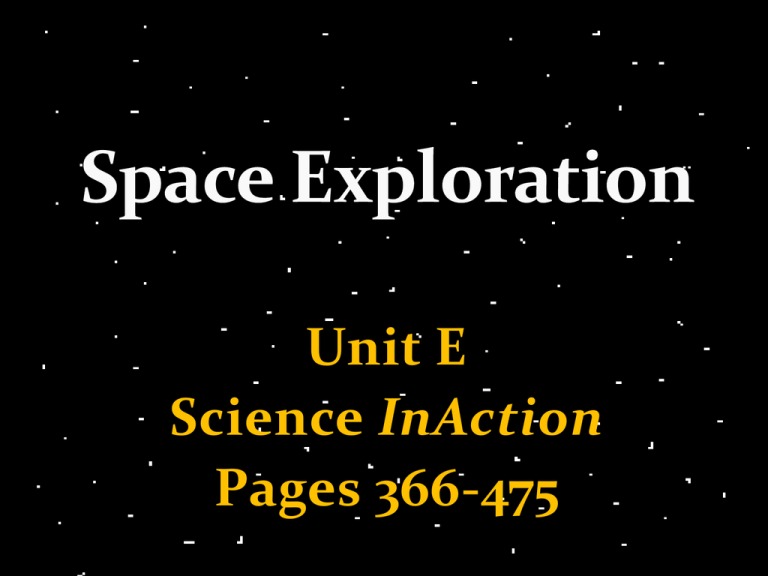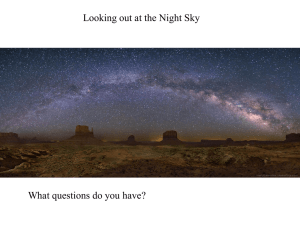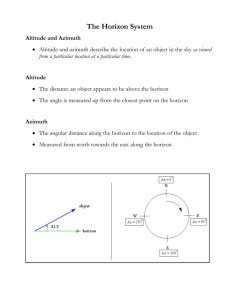Unit E Space Exploration Section 1 NotEarth and Space has
advertisement

Unit E Science InAction Pages 366-475 Human understanding of both Earth and space has changed over time. Objects in the sky have fascinated humans throughout time. The explanations of how these celestial objects came to be are even more fascinating. Early View Hyperlink Myths, folklore and legends were used to explain what ancient people observed in the night sky. First Nations people of the Pacific Northwest believed the night sky was a pattern on a great blanket overhead, which was held up by a spinning 'world pole' resting on the chest of a woman named Stone Ribs. Inuit in the high Arctic - used a mitt to determine when seal pups would be born, by holding the mitt at arm's length at the horizon. represents the shortest and longest periods of daylight Winter solstice - shortest period of daylight (Northern hemisphere Dec. 21) Summer solstice - longest period of daylight (Northern hemisphere - June 21) The Ancient Celts set up megaliths, in concentric circles, at Stonehenge to mark the winter and summer solstices. Ancient African cultures set large rock pillars into patterns to predict the timing of the solstices as well. represents periods of equal day and night Autumnal equinox - occurs in the fall (Northern hemisphere - Sept. 22) Vernal equinox - occurs in the spring (Northern hemisphere - Mar. 21) The Ancient Egyptians built many pyramids and other monuments to align with the seasonal position of certain stars. The Mayans of Central America built an enormous cylinder shaped tower, at Chichen Itza, to celebrate the two equinoxes. Aboriginal Peoples of Southwestern Alberta used key rocks, which aligned with certain stars, in their medicine circles. Ancient cultures tried to explain the motions of the stars and planets. Geocentric - Aristotle's Model Assisted by Pythagoras and Euclid Heliocentric - Copernicus' Model Confirmed by Galileo and Kepler Geocentric and Heliocentric Section 1.2 Pages 377-383 The earliest astronomers used several tools to chart the position of objects in the sky and to predict where the sun, moon, and certain stars would move. With the heavens serving as both timekeeper and navigational aid, such knowledge was of much more than scholarly interest Before 1609, when Galileo began using a brand new invention called the telescope, humankind's perception of the cosmos was limited to what could be seen with the naked eye. It was natural to perceive Earth as the center of the universe (geocentric), with a transparent, starry sphere rotating around it. Designed by Tycho Brahe Tychonian quadrant was actually a very large brass quadrant, affixed to a wall. Its radius measured almost two meters and was graduated in tens of seconds. Sightings were taken along the quadrant through the small window in the opposing wall, to which Tycho points. Allowed the observers to note the precise moment of observation. Instrument used to observe the stars and determine their position on the horizon. The back had a moveable sighting arm and a scale for measuring altitude, while the front had a map of the heavens that helped to calculate the future position of objects. Astronomers could predict when the sun and certain bright stars would rise or set on any given day. Ipparch invented the astrolabe in the 2nd century B.C. In the Middle Ages the astrolabe was the main instrument for navigation later to be replaced by the sextant. At the beginning of the 20th century the prismatic astrolabe appeared, enabling the rays of a celestial body to be reflected onto a mercury surface to determine the point in time that it reached a certain height on the horizon. Tool for measuring the angular altitude of a star above the horizon, which was usually the sun. Used for navigation. Could be used to measure the height of a celestial body from aircraft, spacecraft or the ship's deck. The main types are the sextant used for ships and the bubble sextant used only on aircraft. Made up of a straight staff, marked with graduated scales, with a closefitting, sliding crosspiece. The navigator rested the staff on his cheekbone and lined up one end of the moving crosspiece with the horizon and the other end with the bottom of the pole star, or the sun at midday. The position of the cross piece on the staff gave the reading of altitude. The astronomical unit (AU) is used for measuring 'local' distances in the solar system. It is equal to the distance from the center of the Sun to the center of the Earth (approximately 149,599,000 kms). 1 AU It is used for longer distances - to stars and galaxies. Speed of light approximately 300 000 km/s A light year is equal to the distance light travels in 1 year (approximately 9.5 trillion kms). The distance to our nearest star, Proxima Centauri is a little over 4 light years. A parsec is a basic unit of length for measuring distances to stars and galaxies Equal to 206,265 times the distance from the earth to the sun, or 3.26 light-years. The nearest star, Proxima Centauri is about 1.31 parsecs from the Earth. When you view an object in the sky you are seeing it as it was in the past. Light from the Sun takes about 5 minutes to reach the Earth, whereas light from Pluto takes about 5 hours. The farther away, the longer light takes to reach the Earth. Light from the stars in the center of the universe takes about 25,000 years to reach the Earth. The Hubble telescope is capturing light from 12 billion years ago. Section 1.3 Pages 384-391 A star is a hot, glowing ball of gas (mainly hydrogen) that gives off light energy. Very hot stars look blue, while cooler stars look red. In the 1920's, Ejnar Hertzsprung and Henry Norris Russell compared the surface temperature of stars with its brightness (luminosity). Stars fall into distinct groupings. An enormous explosion that marks the death of a massive star. Fusion has stopped and the star runs out of fuel. Gravity causes the star to collapse upon its self. The outer part of the star explodes with a shock wave. A highly dense remnant of a star in which gravity is so strong that not even light from radiation going on inside the remnant can escape. Event horizon – point at which light cannot escape. Invisible to telescopes. This shows how the path of a beam of light bends in the vicinity of a nonrotating black hole. Constellations are the groupings of stars we see as patterns in the night sky. There are 88 constellations and many are explained in Greek Mythology. Asterisms are also groupings of stars but are not officially recognized as constellations. A galaxy is a grouping of millions or billions of stars, gas and dust. Held together by gravity. The Milky Way Galaxy is the galaxy our solar system is a part of. It is shaped like a flattened pinwheel, with arms spiralling out from the center. Spiral – long curved arms radiating out from a bright central core – older to younger at the arms Elliptical – football or egg – mostly old stars Irregular – no notable shape – smaller size – mixture of young and old stars Section 1.4 Pages 392-400 The Sun emits charged particles in all directions. This solar wind bombards the Earth at 400km/s, but the magnetic field of the Earth protects us. 1. A cloud of gas & dust in space begin swirling 2. Most of the matter (more than 90% of it) accumulates in the center - forming the Sun 3. The remaining materials accumulate (forming planets) and circle the Sun Closest planet to the Sun Surface similar to our moon No atmosphere High temperature – 400oC sunny side - 180oC dark side Similar in size, mass, and gravity to earth High surface temperature – 450oC (melt lead) 90 x atmospheric pressure to Earth CO2 cloud cover Rotates opposite to other planets – east to west Only planet where water exists in solid, liquid, and gas Only planet to support life Atmosphere provides protection from the Sun 70% surface covered in water Active volcanism Red planet – orangish – caused by iron oxides on surface Two polar ice caps (One of Co2 + H2O and one of CO2) Extremely cold surface temperature Varied surface topography 2 moons Largest of all planets Twice the mass of all other planets combined Composed of mainly hydrogen and helium Great Red Spot – atmospheric storm Three thin rings 28 moons 19 moons Second largest planet 1000+ rings surround equator Composed mostly of hydrogen and helium High wind speeds over 1800 km/h due to fast rotation Unusual axis of rotation – tilted toward the plane of its orbit –making it appear to roll its orbit Composed mostly of hydrogen and helium Methane in atmosphere gives it its blue colour Large ring system 17 moons Composed mostly of hydrogen and helium, and methane Methane in atmosphere gives it its blue colour Little light reaches this planet Fastest wind speed – 2500 km/h Own ring system 8 moons Cold frozen ball of methane Disqualified as a Planet due to its obit around the sun at 17.2o – more elliptical Rotates east to west rather than west to east Some astronomers believe it and Charon (moon) are comets that have been captured by the gravity of the sun Originated from the Kuiper Belt Asteroids – rocky , metallic bodies ranging in size of a few meters to hundreds of kilometres Comets – dirty snowballs – dust and ice and heat up when they come close to the sun, releasing gas Comets have predictable paths – large ellipses Meteoroids – small pieces of rock flying through space with not particular path Meteor – a meteoroid that gets pulled into the atmosphere by gravity – heats up and gives off light Meteorite – a meteor that hits the surface Solar System Space Videos National Geographic Section 1.5 Pages 401-407 Altitude gives you the "how above the horizon it is” The point straight overhead has an altitude of +90 degrees Straight underneath, an altitude of -90 degrees. Points on the horizon have 0 degree altitudes. An object halfway up in the sky has an altitude of 45 degrees. Azimuth determines "which compass direction it can be found in the sky." An azimuth of zero degrees puts the object in the North. An azimuth of 90 degrees puts the object in the East. An azimuth of 180 degrees puts the object in the South, and one of 270 degrees puts the object in the west. Zenith is the position in the sky directly overhead. The path in the sky along which the Sun takes is called the ecliptic. The Celestial Sphere is the name given to the very large imaginary 'sphere of sky' surrounding the Earth. Page 406 Questions 2-3, 5-7, 10- 11, 13-15, 17 Read Section 2 pages 408-433






